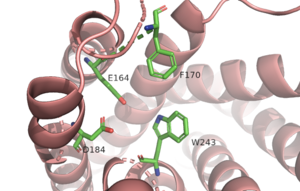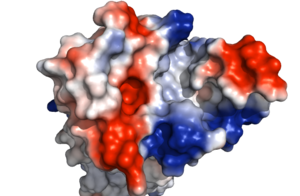Sandbox Reserved 1719
From Proteopedia
(Difference between revisions)
| Line 4: | Line 4: | ||
== Introduction == | == Introduction == | ||
| - | [[G protein-coupled receptors]] (GPCRs) are the largest class of integral membrane proteins. GPCRs are divided into five families; the rhodopsin family (class A), the secretin family (class B), the glutamate family (class C), the frizzled/taste family (class F), and the adhesion family.<ref name= "Zhang 2006"/> | + | [[G protein-coupled receptors]] (GPCRs) are the largest class of integral membrane proteins. GPCRs are divided into five families; the rhodopsin family (class A), the secretin family (class B), the glutamate family (class C), the frizzled/taste family (class F), and the adhesion family.<ref name= "Zhang 2006"/> All GPCRs contain a similar seven α-helical transmembrane domain <scene name='72/727091/Full_Structure_with_Labels/1'>(TMD or 7TMD)</scene> that once bound to its ligand, undergoes a conformational change and tranduces a signal to coupled, heterotrimeric G proteins. The initiation of intracellular signal pathways occur in response to stimuli such as light, Ca<sup>2+</sup>, amino acids, nucleotides, odorants, peptides, and other proteins, [https://en.wikipedia.org/wiki/G_protein%E2%80%93coupled_receptor#Physiological_roles and accomplishes many interesting physiological roles]. <ref name= "Zhang 2006">DOI 10.1371/journal.pcbi.0020013</ref> |
GPCRs<ref>PMID: 20019124</ref>. | GPCRs<ref>PMID: 20019124</ref>. | ||
Revision as of 20:15, 15 March 2022
Human Itch G-Coupled Protein Receptors
| |||||||||||


